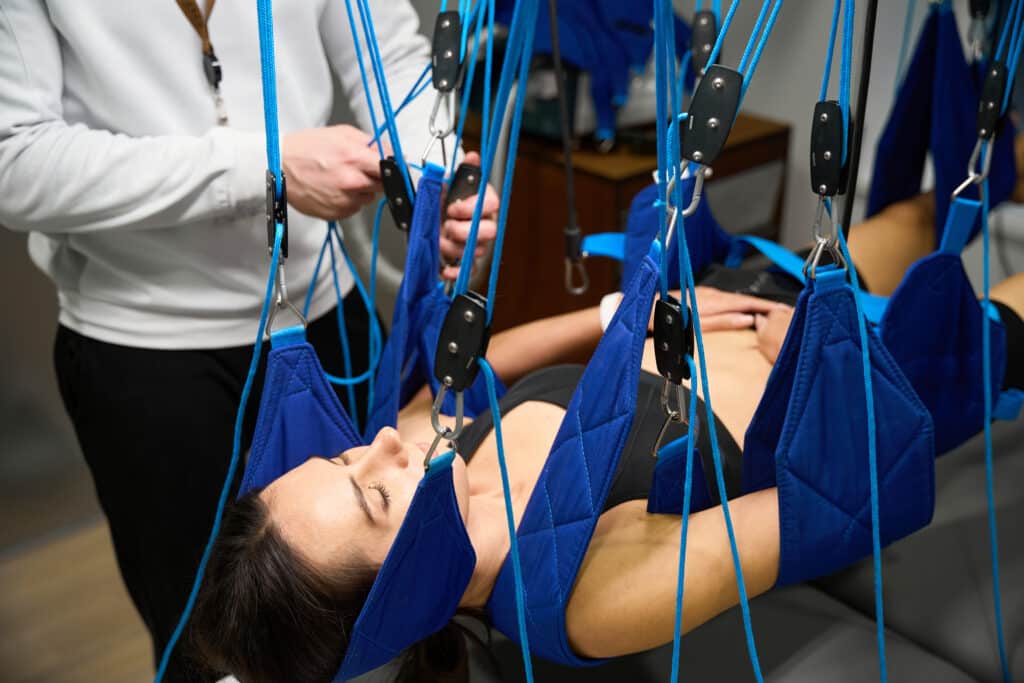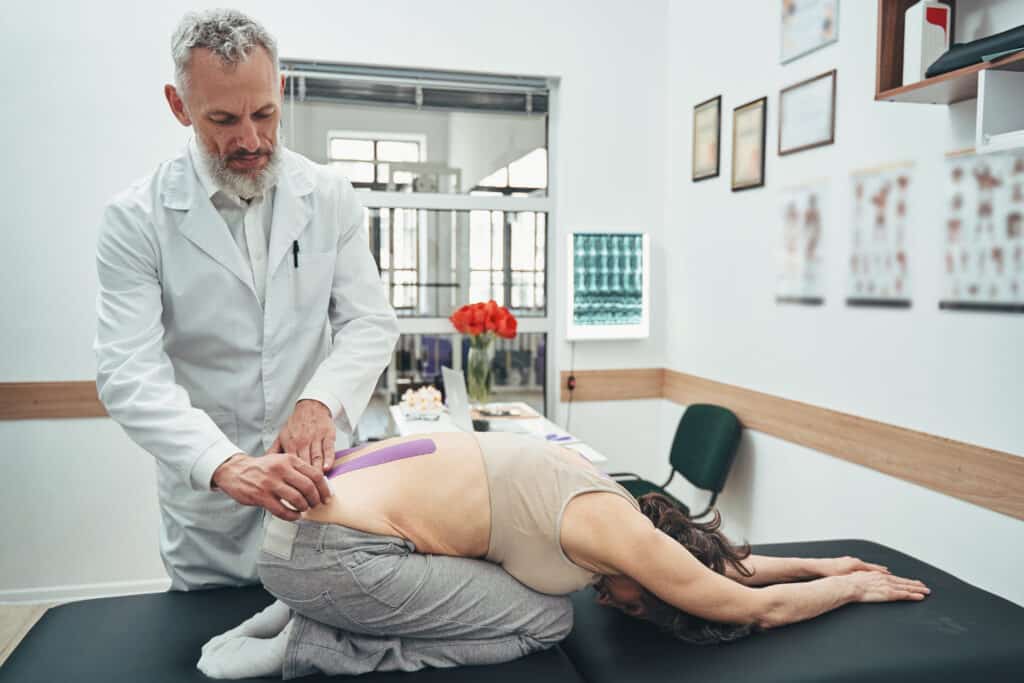
Table of Contents
ToggleSpinal fusion is a surgical procedure aimed at stabilizing the spine by fusing two or more vertebrae together. This is commonly performed for patients suffering from conditions like degenerative disc disease, scoliosis, or spinal instability.
The fusion process uses bone grafts, cages, or hardware to connect the vertebrae, which eventually heal into a single solid bone. This procedure alleviates pain, improves stability, and allows patients to return to their normal activities with less discomfort.

As a spine surgeon with over 25 years of experience, I understand how overwhelming the recovery process after spinal fusion surgery can be. Patients often wonder, “What’s next?” after the surgery.
I’ve designed this comprehensive guide to walk you through the spinal fusion post-op protocol, which is essential to optimize your recovery and achieve the best outcome. This post-op protocol not only helps support the healing process but also prevents complications like infection or hardware failure.
When discussing a spinal fusion post-op protocol, we’re referring to a structured set of guidelines that dictate how you should manage your recovery from the moment you leave the operating room until you’re fully healed. These protocols cover everything from pain management to physical therapy and gradually reintroducing activities to your daily life.
Below, I’ll break down each phase of recovery and highlight critical areas such as pain management, activity restrictions, and physical therapy. It’s important to adhere to this protocol closely to ensure a smooth recovery and long-term success. Read more here.
The first phase of recovery begins immediately after surgery. During this time, the focus is primarily on pain management, limited mobility, and wound care.
You’ll be in the hospital for a few days following surgery, where the healthcare team will monitor you closely for any signs of complications.
Pain Management
Pain is a natural part of the recovery process, especially in the initial stages. In the first few days, patients are often prescribed opioids to manage severe pain.
However, my goal is always to help patients transition to less potent pain relievers as soon as possible. We typically reduce opioid use within a week or two, replacing it with NSAIDs (like ibuprofen) and acetaminophen to control pain and inflammation.
I also recommend using ice packs intermittently to help reduce swelling and discomfort around the surgical area. Additionally, some patients benefit from using a TENS unit (transcutaneous electrical nerve stimulation) to help manage pain.
This device delivers low-voltage electrical currents to the affected area, interrupting the pain signals sent to your brain. In my experience, patients have found this to be particularly helpful in managing post-operative discomfort without relying solely on medications. Read more here.
Activity Restrictions
During the first six weeks, patients must adhere to strict movement restrictions. Bending, lifting, and twisting (often called the BLT restrictions) should be avoided entirely.
The spine is highly vulnerable during this period, and even simple movements can disrupt the fusion process. I recommend that patients avoid lifting anything heavier than 5-10 pounds, which is roughly the weight of a gallon of milk.
At this stage, you may need assistance with daily activities like dressing or getting out of bed. I always advise patients to take things slowly and avoid any sudden movements that could cause strain on the surgical site.
If necessary, you may be fitted with a back brace to provide additional support as you move around. While this may feel restrictive, it plays a crucial role in keeping the spine stable and reducing the risk of complications.
Wound Care
Proper wound care is critical during this phase. Your incision must be kept clean and dry to prevent infection.
Typically, your surgeon will provide specific instructions on how to care for your incision site. I often recommend cleaning the area with mild soap and water, followed by patting it dry gently.
You should also avoid submerging the incision in water (no baths or swimming) until it is fully healed. Any signs of infection—such as increased redness, swelling, warmth, or discharge from the incision—should be reported to your surgeon immediately.
Early detection and treatment of infections are essential to prevent further complications.
After the initial six weeks, patients typically transition into the early rehabilitation phase, where they can begin light activities and, under professional guidance, start physical therapy. This phase focuses on increasing mobility and strength while still maintaining precautions to protect the spine.
Physical Therapy Initiation
Starting physical therapy during this phase is crucial for promoting healing and restoring movement. Your physical therapist will guide you through a series of gentle exercises designed to improve strength and flexibility without placing too much stress on the spine.
These exercises typically focus on core stabilization, including activating the transversus abdominis and pelvic floor muscles. Simple exercises like glute bridges, heel slides, and supine marching help strengthen the muscles that support your spine without compromising the fusion process.
It’s important to follow your physical therapist’s instructions carefully, as overdoing it can hinder the healing process. Progression should be slow and steady, focusing on form and control rather than intensity.
Increasing Activity Levels
While you may still have some movement restrictions during this phase, you’ll be encouraged to gradually increase your activity level. Light walking is one of the best ways to stay active during recovery without putting too much pressure on the spine.
Aim for 15-20 minutes of walking each day, gradually increasing this as your strength and endurance improve. By week 12, many patients can handle light exercises that target the lumbar paraspinals and other muscles involved in spine stabilization.
However, it’s essential to avoid activities that involve bending or twisting the spine, as these movements can place too much strain on the fusion site.
Monitoring for Complications
As you become more active, it’s important to keep an eye out for any signs of complications. If you experience new or worsening pain, numbness, or tingling in your extremities, it’s crucial to contact your surgeon immediately.
These symptoms could indicate a problem with the fusion or other complications like hardware failure or nerve impingement. I always remind my patients to listen to their bodies during this phase.
While some discomfort is expected, any sharp or severe pain should not be ignored. Your healthcare team will be there to guide you through this process and ensure that any issues are addressed promptly.

By the 12-week mark, most patients are well on their way to recovery, but the spine still requires ongoing care and attention. During this phase, the goal is to gradually return to more normal activities, including work and exercise, while continuing to protect the fusion site.
Resuming Daily Activities
Many patients are eager to return to their normal activities at this stage, including work. However, it’s essential to make a gradual return, especially if your job involves physical labor.
For those with sedentary jobs, returning to work part-time may be an option around the 12-week mark, but this will depend on your progress and the nature of your work. Patients should continue to avoid heavy lifting and activities that involve excessive bending or twisting, but light household chores and other daily activities can usually be resumed with caution.
I recommend working closely with your physical therapist during this phase to ensure that you’re moving in a way that supports your spine and avoids undue strain.
Strengthening and Conditioning
As your body heals, you’ll be able to gradually increase the intensity of your exercise regimen. This includes more advanced core strengthening exercises and gentle resistance training, which help build strength in the muscles that support your spine.
Exercises like wall squats, planks, and bird-dog variations are excellent for building strength without putting undue pressure on your spine. At this stage, many patients can also introduce low-impact cardiovascular activities like cycling or swimming into their routine.
These activities help improve overall fitness and support the healing process by increasing blood flow to the muscles and bones.
Nutrition and Bone Healing
Bone healing is a critical part of the recovery process, and patients can support this by paying attention to their diet. During this phase, I recommend focusing on nutrient-dense foods that support bone health, such as leafy greens, dairy products, and fish high in omega-3 fatty acids.
Patients should also ensure they’re getting enough calcium and vitamin D, which are essential for strong bones. For patients who smoke, it’s crucial to stop smoking during this time, as smoking can significantly impair the body’s ability to heal and fuse the bones.
Similarly, avoiding alcohol can also help support the healing process, as alcohol can interfere with bone metabolism.
While the majority of recovery occurs in the first three to six months after surgery, it’s important to remember that full recovery from spinal fusion can take up to a year. During this time, patients should continue to focus on maintaining their strength, flexibility, and overall health to support the fusion process and prevent future problems.
Returning to Vigorous Activities
By the six-month mark, many patients are able to return to more vigorous activities, including exercises that involve higher levels of resistance or low-impact sports. Activities like swimming, walking, and using a stationary bike are excellent options during this time.
For those who enjoy activities like yoga or Pilates, I recommend consulting with a physical therapist or instructor who is knowledgeable about spinal health to ensure that you’re practicing movements that won’t put undue strain on your spine. However, it’s essential to avoid any high-impact activities such as running, jumping, or contact sports for at least 12 months.
The fusion site is still stabilizing during this period, and these activities could potentially disrupt the healing process. I always tell my patients that the key to a successful long-term recovery is patience and gradual progression.
It’s much better to take things slowly and allow your body the time it needs to heal fully.
Monitoring Bone Fusion Success
At this stage, your surgeon will likely order follow-up imaging, such as X-rays or CT scans, to assess how well the bones have fused. The images will help determine whether the fusion is progressing as expected or if there are any issues that need to be addressed.
If the fusion is progressing well, patients can expect to continue increasing their activity levels and eventually return to their pre-surgery routines. However, in some cases, patients may experience delayed fusion or non-union, where the bones don’t fuse as expected.
If this occurs, additional treatment options may be considered, such as the use of a bone growth stimulator or even revision surgery. Fortunately, these cases are relatively rare, and most patients heal successfully with proper post-op care.
Long-Term Pain Management
While most patients experience significant pain relief after spinal fusion surgery, some may continue to have residual discomfort or chronic pain. In these cases, it’s important to explore long-term pain management options, such as physical therapy, chiropractic care, or pain management specialists.
I often work with a team of healthcare providers to ensure that my patients receive comprehensive care that addresses their individual needs. In some instances, patients may benefit from cognitive-behavioral therapy (CBT), which has been shown to help patients manage chronic pain by teaching them coping strategies and helping them change their relationship with pain.
Additionally, certain medications or nerve blocks may be appropriate for managing long-term pain, though these are typically used as a last resort after other treatments have been explored.
Avoiding Future Spine Issues
One of the most important aspects of long-term recovery is preventing future spine problems. Patients who have undergone spinal fusion surgery are at a higher risk of developing adjacent segment disease (ASD), where the vertebrae above or below the fused segment start to wear down due to increased stress.
To minimize the risk of ASD, it’s important to maintain good posture, practice safe lifting techniques, and engage in exercises that support spine health. I recommend focusing on core strengthening exercises that improve the stability of the spine without causing additional strain.
Activities like planks, side bridges, and bird-dog exercises are excellent for this purpose. Additionally, maintaining a healthy weight and avoiding smoking can help reduce the risk of future spine issues.
By the 12-month mark, most patients have fully recovered from spinal fusion surgery and are able to return to their normal activities, including work, exercise, and recreation. At this point, the fusion should be complete, and the spine should be stable.
Returning to Work
For patients with physically demanding jobs, it’s crucial to ease back into work carefully. Heavy lifting, bending, and other strenuous activities should be reintroduced gradually, with attention to proper body mechanics to prevent injury.
For those in more sedentary roles, it’s still important to take regular breaks, stretch, and ensure proper ergonomic support to avoid strain on the spine. I’ve had many patients successfully return to demanding careers after spinal fusion, but I always remind them that long-term success depends on maintaining the healthy habits they developed during recovery.
Patients should continue to prioritize spine-friendly practices, including proper lifting techniques and maintaining strong core muscles.
Returning to Exercise and Sports
By the 12-month mark, many patients are eager to return to their favorite sports and activities. For most, this is possible with the right precautions.
Low-impact activities like swimming, cycling, and yoga are usually safe, but high-impact activities such as running, skiing, or contact sports may still carry a higher risk for some patients. For those who participate in high-risk sports, I recommend a slow and careful return, often in consultation with a physical therapist or trainer experienced in working with post-operative spine patients.
With proper guidance and a focus on injury prevention, many patients can enjoy a full return to the activities they love.
Long-Term Health and Maintenance Even after the fusion has healed, it’s important to maintain the habits developed during recovery. Regular exercise, particularly core strengthening, should be a part of every patient’s routine to support long-term spine health.
Additionally, keeping weight under control, avoiding smoking, and maintaining a nutrient-rich diet can all help reduce the risk of future spine issues. As a spine surgeon, I’ve seen firsthand the importance of long-term health maintenance.
Spinal fusion is a major surgery, but with the right post-op protocol and long-term care, most patients can return to their normal lives with minimal pain and discomfort.
Monitoring for Long-Term Complications
Although complications after spinal fusion surgery are rare, it’s important to stay vigilant and monitor for any signs of problems in the years following surgery. If patients experience new or worsening pain, numbness, or tingling, it’s important to consult with a healthcare provider to determine the cause.
In rare cases, patients may develop issues like hardware failure or adjacent segment disease. Early intervention is key to managing these complications and ensuring long-term success.
Regular follow-up appointments with your surgeon, including imaging studies, can help catch any issues early before they become more serious.

In my over 25 years of experience as a spine surgeon, I’ve seen the profound impact that a well-structured post-op protocol can have on a patient’s recovery. Following the spinal fusion post-op protocol is essential to ensure that the fusion heals properly, pain is managed effectively, and patients can return to their daily activities with confidence.
The key to a successful recovery is patience, adherence to the protocol, and maintaining open communication with your healthcare team. Every patient’s recovery journey is unique, and the best results come from a combination of personalized care, physical therapy, and self-care.
Whether you’re just starting your recovery or you’re months into the process, remember that your body needs time to heal, and a thoughtful approach will lead to the best long-term outcomes. By following the spinal fusion post-op protocol and staying committed to your recovery, you’ll be back to living your life with a healthier, stronger spine.
GET IN TOUCH +
285 Sills Road
Building 5-6, Suite E
East Patchogue, NY 11772
(631) 475-5511
184 N. Belle Mead Road
East Setauket, NY 11733
(631) 675-6226
GET IN TOUCH +
285 Sills Road
Building 5-6, Suite E
East Patchogue, NY 11772
(631) 475-5511
184 N. Belle Mead Road
East Setauket, NY 11733
(631) 675-6226
SUBSCRIBE TO OUR NEWSLETTER +
Send us a Google review. Click this link and let us know how we did!
Review us on Yelp too.